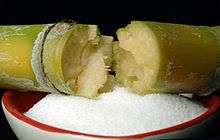Cuban sugar economy
The Cuban sugar economy is the principal agricultural economy in Cuba. In two years after World War II, the price of sugar in Cuba went from 4 cents a pound to more than 20 cents a pound.[1] It soon experienced a bust as the European economy reprospered after the war, and its prices went below four cents, causing ruin to many sugar farmers.[2] It was subject of a reciprocal trade pact with the Soviet Union. In 1969-1970 Fidel Castro issued a crash goal that his subjects harvest 10 million tons of sugar cane in 1970. Although the 7.56 million tons of sugar harvested in 1970 set a Cuban record, it was not sufficient in sustaining the Cuban economy at the level of success that had been expected by the island's citizenry. The disappointing outcome permanently affected the sociopolitics of Cuba.[3]
